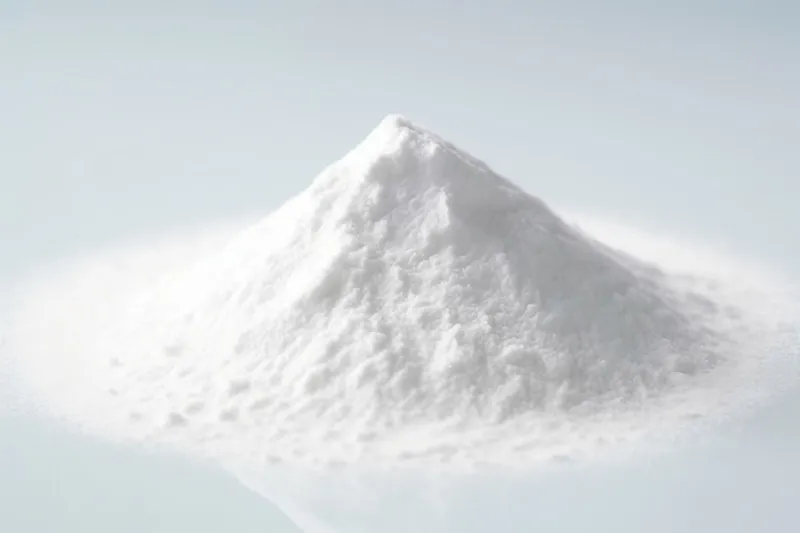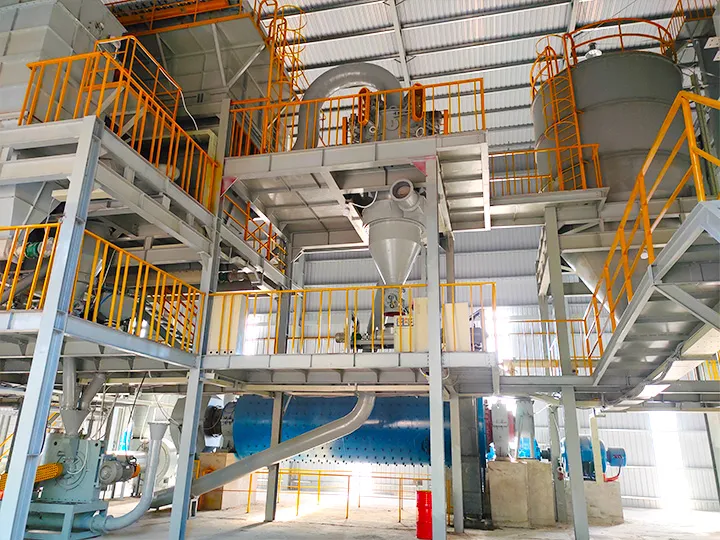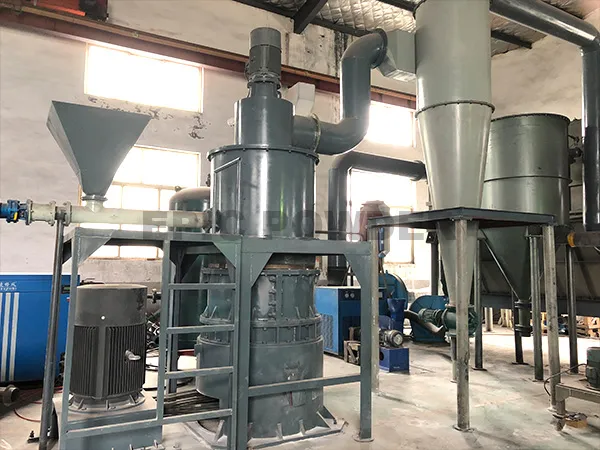Calcium carbonate is an inorganic compound with the chemical formula CaCO₃ and is the main component of limestone, marble, etc. Calcium powder is usually white crystals, odorless, essentially insoluble in water, and reacts readily with acids to release carbon dioxide. It is one of the common substances found on earth within rocks such as aragonite, calcite, chalk, limestone, marble, travertine, etc. It is also a major component of the bones or shells of some animals. CCC is also an important building material with various industrial uses.
Physical Properties of Calcium Carbonate
Calcium carbonate is a white micro-fine crystalline powder, tasteless and odorless. It has two forms: amorphous and crystalline. Crystalline can be divided into rhombohedral and hexagonal crystal systems (anhydrous Calcium powder is colorless rhombohedral crystals, hexahydrate calcium powder is colorless monoclinic crystals), columnar or rhombic, density 2.93g/cm3. melting point 1339 ℃ (825-896.6 ℃ has been decomposed), the melting point of 1289 ℃ under 10.7MPa. Almost insoluble in water, soluble in water containing ammonium salt or iron trioxide, and insoluble in alcohol.
Calcium Carbonate Structure
The crystal structure is an orthorhombic crystal system. Each GCC molecule consists of one carbon atom and three oxygen atoms, where each oxygen atom is attached to a calcium ion. Calcium carbonate consists of calcium ions forming ionic bonds with carbonate ions, and carbonate internally consists of carbon-oxygen covalent bonds. Among them, carbonate belongs to sp2 hybridization, the central carbon atom has three orbitals and a p-orbital, according to the VSEPR model, belongs to the AY3-type molecule, and its VSEPR ideal model is a planar triangle, and there are 3 C-O bonds in the molecule in the form of planar triangles; in addition, it also has a 4-orbital, 6-electron p-p large bond. In crystals, GCC molecules are arranged in layers parallel to the a- and c-axes. Coplanar oxygen atoms interconnect these layers and form a three-dimensional mesh. This structure gives calcium powder high stability and hardness.
Calcium carbonate chemical properties
- Calcium powder decomposes into calcium oxide and carbon dioxide at 825-896.6 °C. (Industrial production of CO₂):
- Calcium powder will and dilute acid (such as acetic acid, hydrochloric acid, dilute nitric acid, etc.) bubble boiling and dissolve. The reaction also releases carbon dioxide in an exothermic reaction. For example, and dilute hydrochloric acid reaction to produce calcium chloride, water, and carbon dioxide (laboratory production of CO₂):
- Water mixed with CaCO3 passes through excess carbon dioxide to form a calcium bicarbonate solution. Calcium powder reacts with carbonic acid (rainwater) to produce calcium bicarbonate. Pass CO2 into turbid lime water, and the residue disappears. The principle of these phenomena is:
- Anhydrous calcium powder (white, odorless, non-toxic powdery substance, light calcium carbonate) is transformed into calcite (tripartite crystal system, heavy calcium carbonate) when heated to 1000K
According to the different production methods of calcium powder, Calcium powder can be divided into heavy calcium carbonate, light calcium powder, colloidal GCC, and crystalline calcium carbonate. According to the size of the average particle size (d) of calcium carbonate powder, calcium carbonate can be divided into particulate GCC (d>5μm), micronized calcium powder (1-5μm), microfine calcium carbonate (0.1-1μm), ultrafine GCC (0.02-0.1μm) ultrafine calcium powder (d ≤ 0.02μm). According to whether the arrangement of atoms and ions composing calcium carbonate is regular or not, calcium powder can be divided into crystalline calcium powder and amorphous calcium powder . In addition, there are nano calcium powder , etc.
Calcium carbonate classification
Heavy Calcium Carbonate
Heavy calcium carbonate (bicarbonate) is produced by directly crushing natural calcite, limestone, chalk, shells, etc., using mechanical methods (with Raymond mills or other high-pressure mills).

Light Calcium Carbonate
Light calcium carbonate (commonly known as light calcium), also known as precipitated calcium carbonate, is calcined limestone and other raw materials to generate lime (the main component of calcium oxide) and carbon dioxide, and then water to digest the lime to generate milk of lime (the main component of calcium hydroxide), and then carbon dioxide carbonation of the milk of lime to generate calcium carbonate precipitation, and finally by dehydration, drying and crushing and produced. First sodium carbonate and calcium chloride complex decomposition reaction to generate calcium powder sediment, and then by dehydration, drying, and crushing and produced.
Colloidal Calcium Carbonate
Colloidal calcium carbonate, also known as activated calcium powder, modified calcium carbonate, surface treatment of calcium powder , gelatinous calcium carbonate, or white manhua, referred to as live calcium, is the use of surface modifiers to light calcium powder or heavy calcium carbonate surface modification and produced. Because of the surface modifier, modified calcium powder generally has a reinforcing effect, that is, the so-called “active”, so it is customary to modify the calcium carbonate, which is called active GCC.
Properties: Colloidal calcium carbonate is a very fine white powder, odorless, tasteless, the particles are similar to spheres, with a particle size of 0.1um or less, because of a layer of fat soap adsorbed on the surface of the particles, so it has a colloidal activation performance is an excellent white reinforcing filler. Dissolved in water, decomposed by acid, burnt to burnt black, release carbon dioxide and generate calcium oxide. Specific gravity 1.99~2.01.
Crystalline Calcium Carbonate
Calcium hydroxide and hydrochloric acid reaction to generate calcium chloride, activated carbon decolorization, and removal of impurities, so that the calcium chloride in the presence of ammonia carbonated with carbon dioxide that is calcium powder , and then after crystallization, separation, washing, dehydration, drying, screening system.
Properties: pure white, hexagonal crystalline powder. Specific volume 1.2~1.4ml/g. Soluble in acid, almost insoluble in water.
Uses: Used in toothpaste, medicine, etc. It can also be used as thermal insulation and other chemical raw materials.
Nano calcium carbonate
Nano calcium carbonate (ultrafine calcium carbonate) has a particle size of 1-100nm. It is a new powder material developed in the 1980s. It is an excellent inorganic filler.
It can improve or change the rigidity, toughness, and bending strength of plastics and resins. It can improve the plastic processing system’s flow. It lowers the plasticizing temperature. It also boosts the product’s size stability, heat resistance, and surface finish.
In NR, BR, and SBR rubber systems, it mixes easily and disperses uniformly. It can soften the rubber and improve extrusion performance and fluidity.
Rubber products have a smooth surface. They have a high elongation, tensile strength, and tear strength. They also have a small permanent deformation and good bending resistance. Nano-calcium carbonate has a unique crystal and surface structure. It differs from ordinary calcium powder. It has great quantum size and surface effects in the chemical industry, catalysis, optics, magnetism, and electricity. But, calcium carbonate nanoparticles tend to clump together. Their surface is hydrophilic and oleophobic. This limits their use in organisms.
Calcium carbonate industrial use
Calcium carbonate is the trade name for limestone, a valuable, versatile resource. Limestone has been widely used throughout history. It is abundant and easy to access. Limestone is an important building material with a long history of mining. In modern industry, it is the main raw material for making cement, lime, and calcium carbide. It is also a key frit in the metallurgical industry. High-quality limestone, when ultra-fine ground, is widely used in making products like paper, rubber, paint, coatings, pharmaceuticals, cosmetics, and feed. It is also used in sealing, bonding, and polishing. Incomplete stats show a 1:3 ratio for limestone use in cement, lime, and ultrafine GCC. Limestone is a non-renewable resource. With advances in science and nanotech, its uses will grow.
For plastics production
Calcium carbonate is widely used in filling polyvinyl chloride (PVC), polyethylene (PE), polypropylene (PP), acrylic butadiene-styrene copolymer (ABS), and other resins. The addition of calcium carbonate has a role in improving certain plastic product properties to expand their applications. In plastics processing, they can reduce resin shrinkage, improve flow patterns, and control viscosity. It can also play the following roles:
(1) Improve the stability of the size of plastic products;
(2) Improve the hardness and rigidity of plastic products;
(3) Improve plastic processing performance;
(4) Improve the heat resistance of plastic products;
(5) Improve the light diffusion of plastic;
(6) Can make the products have some special properties;
(7) Reduce the cost of plastic products.

Used in the food industry
It can be used as an additive in the food industry. For example, it can be used in various feed additives, with a calcium content of more than 55.6 percent and no harmful components. It can be used as a calcium supplement, and the absorption rate can reach 39%, second only to calcium fructate, soluble in gastric acid, and has become the most dosage form and the most used calcium supplement.
Used in the construction industry
It can be used as raw material for plastic factories, rubber factories, paint factories, waterproof material factories, and internal and external wall paintings. It has the characteristics of high purity, high whiteness, non-toxic, non-odor, low fine oil quality, and low hardness. Marble is also an important building material for house construction.
Used in chemical manufacturing
350 mesh to 400 mesh can manufacture fasteners, downpipes, and chemical industries. The whiteness is above 93 degrees. 400 mesh to 600 mesh can be used for toothpaste paste and soap. The whiteness is above 94 degrees. 800 mesh can be used for rubber, cable, and PVC; the whiteness is above 94 degrees.
It can also manufacture raw materials for optical neodymium glass, etc.
For fine ceramic materials
Calcium powder prepares high-temperature stable, dielectric, low thermal conductivity, microporous, and highly pure ceramic materials. Examples include white conductors, widely used in preparing spark plugs, and important fine ceramic materials such as semiconductors, alumina, and enamel pigments.
Uses Mineral fillers and abrasives
Calcium powder for industrial use is also used as a mineral filler and abrasive. In producing chemical and building materials, calcium carbonate can replace some expensive materials such as white lead ore, talc, and talcum powder. In abrasives, the particle surface of calcium carbonate can interact with the abrasive matrix to enhance the abrasion resistance and grinding efficiency of the abrasive to improve the efficiency and durability of the abrasive.
For nutritional supplements
The main ingredient in most calcium tablets on the market is GCC. Calcium powder needs to be taken with meals. Due to its carbonic acid content, calcium powder tends to produce carbon dioxide in an acidic environment. It is unsuitable for people with poor gastric acid secretion or those using gastric acid inhibitors.
Heavy Calcium Carbonate Production Equipment
Calcium carbonate ball milling and classification production line
A calcium carbonate ball milling and classification production line produces GCC powder. It uses both ball milling and air classification processes. This setup is widely used in industries that need fine Calcium powder. These include plastics, paints, rubber, food, and pharmaceuticals.

Ball mills often combine with classifiers to form a production line. It mainly produces D97, 5 to 45μm, ground calcium carbonate fine and ultrafine powders. Different models of ball mill host, its output is also different. Generally speaking, the annual output of the ball mill is between 10,000 tons and 200,000 tons.
Its advanced technology and quality products have won over mid and high-end customers.
Calcium carbonate roller mill production line
A calcium carbonate roller mill production line is a system designed for the grinding and processing of Calcium powder, a widely used industrial mineral. This production line has key components and processes. They ensure efficient, high-quality production.

As the name suggests, the micro powder roller mill crushes the material by rolling and grinding with its multi-layer ring rollers. It is mainly used to produce ultrafine powder of 8-45μm.
Our common micro powder roller mill models have 21 rollers, 28 rollers and 34 rollers. The greater the number of grinding rollers, the greater its output.
